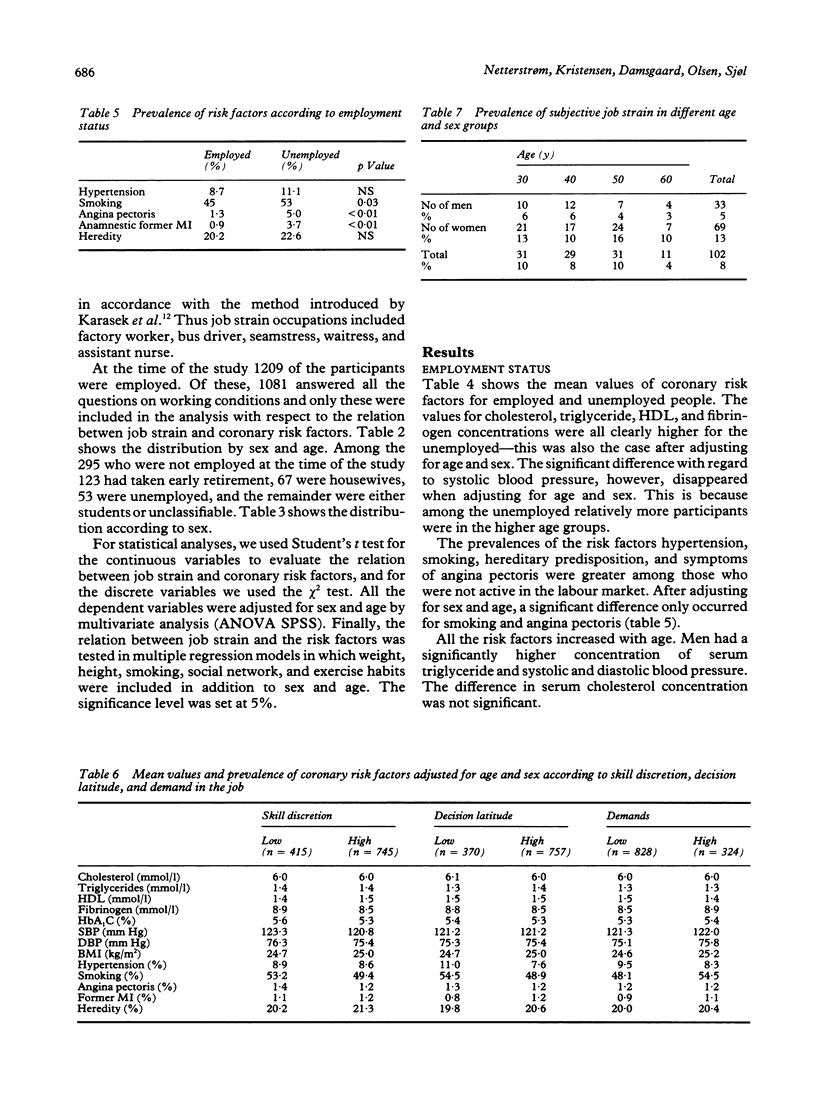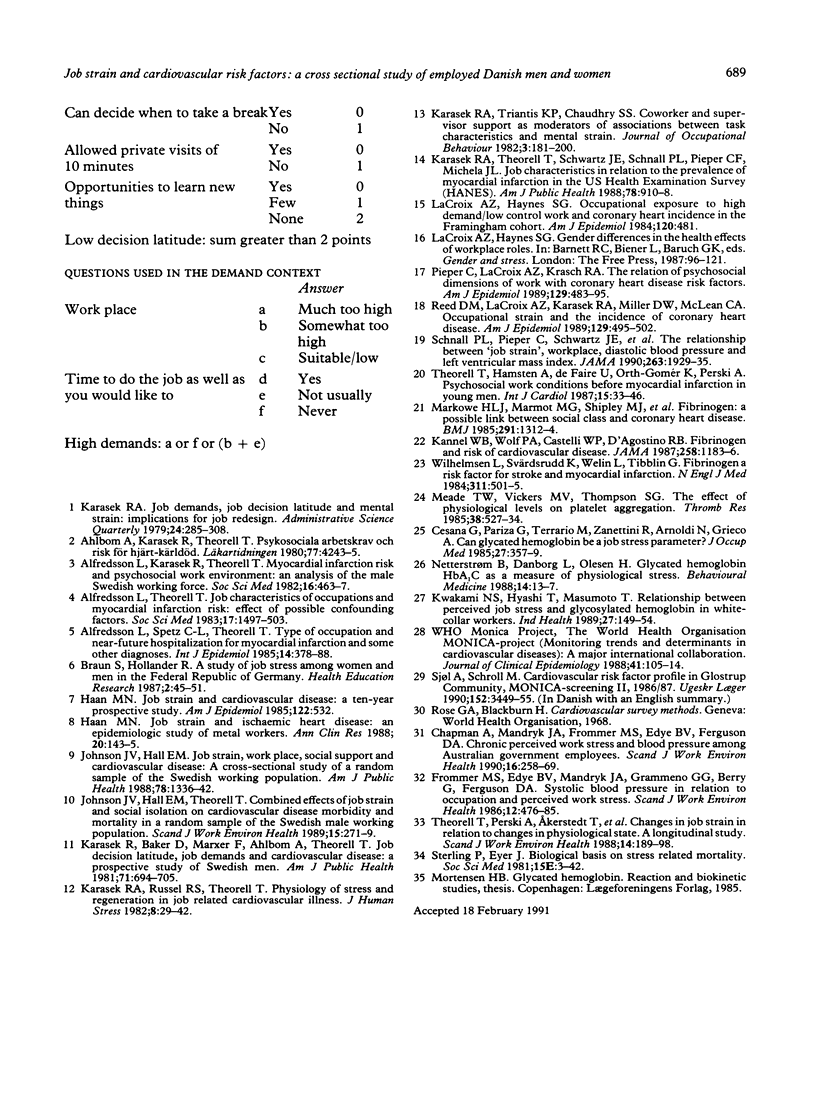Abstract
As part of the World Health Organisation initiated MONICA project, 2000 men and women aged 30, 40, 50, and 60 from the general population were invited to undergo a medical examination with special emphasis on cardiovascular disease. A total of 1504 (75%) participated, 1209 of whom were employed. The participants answered a questionnaire on working, social, and health conditions and underwent clinical examinations that included the measurement of blood pressure and serum cholesterol, triglyceride, high density lipoprotein, fibrinogen, and glycated haemoglobin (HbA1C) concentrations. Using the demand-control model for measuring job strain suggested by Karasek, the employed people were classified according to those who had suffered job strain and those who had not in two different ways. The subjective classification was based on the participants' statements regarding demand and control in their jobs whereas the objective classification was based on job title and mode of payment. More women than men were classified as having high strain jobs. After adjusting for age and sex no significant association was found between coronary risk factors and subjective job strain. A tendency for an association between fibrinogen and job strain was found. Body mass index and HbA1C concentration were significantly associated with objective job strain independent of confounders.
Full text
PDF





Selected References
These references are in PubMed. This may not be the complete list of references from this article.
- Alfredsson L., Karasek R., Theorell T. Myocardial infarction risk and psychosocial work environment: an analysis of the male Swedish working force. Soc Sci Med. 1982;16(4):463–467. doi: 10.1016/0277-9536(82)90054-5. [DOI] [PubMed] [Google Scholar]
- Alfredsson L., Spetz C. L., Theorell T. Type of occupation and near-future hospitalization for myocardial infarction and some other diagnoses. Int J Epidemiol. 1985 Sep;14(3):378–388. doi: 10.1093/ije/14.3.378. [DOI] [PubMed] [Google Scholar]
- Alfredsson L., Theorell T. Job characteristics of occupations and myocardial infarction risk:effect of possible confounding factors. Soc Sci Med. 1983;17(20):1497–1503. doi: 10.1016/0277-9536(83)90094-1. [DOI] [PubMed] [Google Scholar]
- Cesana G., Panza G., Ferrario M., Zanettini R., Arnoldi M., Grieco A. Can glycosylated hemoglobin be a job stress parameter? J Occup Med. 1985 May;27(5):357–360. doi: 10.1097/00043764-198505000-00015. [DOI] [PubMed] [Google Scholar]
- Chapman A., Mandryk J. A., Frommer M. S., Edye B. V., Ferguson D. A. Chronic perceived work stress and blood pressure among Australian government employees. Scand J Work Environ Health. 1990 Aug;16(4):258–269. doi: 10.5271/sjweh.1786. [DOI] [PubMed] [Google Scholar]
- Frommer M. S., Edye B. V., Mandryk J. A., Grammeno G. L., Berry G., Ferguson D. A. Systolic blood pressure in relation to occupation and perceived work stress. Scand J Work Environ Health. 1986 Oct;12(5):476–485. doi: 10.5271/sjweh.2115. [DOI] [PubMed] [Google Scholar]
- Haan M. N. Job strain and ischaemic heart disease: an epidemiologic study of metal workers. Ann Clin Res. 1988;20(1-2):143–145. [PubMed] [Google Scholar]
- Johnson J. V., Hall E. M. Job strain, work place social support, and cardiovascular disease: a cross-sectional study of a random sample of the Swedish working population. Am J Public Health. 1988 Oct;78(10):1336–1342. doi: 10.2105/ajph.78.10.1336. [DOI] [PMC free article] [PubMed] [Google Scholar]
- Johnson J. V., Hall E. M., Theorell T. Combined effects of job strain and social isolation on cardiovascular disease morbidity and mortality in a random sample of the Swedish male working population. Scand J Work Environ Health. 1989 Aug;15(4):271–279. doi: 10.5271/sjweh.1852. [DOI] [PubMed] [Google Scholar]
- Kannel W. B., Wolf P. A., Castelli W. P., D'Agostino R. B. Fibrinogen and risk of cardiovascular disease. The Framingham Study. JAMA. 1987 Sep 4;258(9):1183–1186. [PubMed] [Google Scholar]
- Karasek R. A., Theorell T., Schwartz J. E., Schnall P. L., Pieper C. F., Michela J. L. Job characteristics in relation to the prevalence of myocardial infarction in the US Health Examination Survey (HES) and the Health and Nutrition Examination Survey (HANES). Am J Public Health. 1988 Aug;78(8):910–918. doi: 10.2105/ajph.78.8.910. [DOI] [PMC free article] [PubMed] [Google Scholar]
- Karasek R., Baker D., Marxer F., Ahlbom A., Theorell T. Job decision latitude, job demands, and cardiovascular disease: a prospective study of Swedish men. Am J Public Health. 1981 Jul;71(7):694–705. doi: 10.2105/ajph.71.7.694. [DOI] [PMC free article] [PubMed] [Google Scholar]
- Kawakami N., Araki S., Hayashi T., Masumoto T. Relationship between perceived job-stress and glycosylated hemoglobin in white-collar workers. Ind Health. 1989;27(4):149–154. doi: 10.2486/indhealth.27.149. [DOI] [PubMed] [Google Scholar]
- Markowe H. L., Marmot M. G., Shipley M. J., Bulpitt C. J., Meade T. W., Stirling Y., Vickers M. V., Semmence A. Fibrinogen: a possible link between social class and coronary heart disease. Br Med J (Clin Res Ed) 1985 Nov 9;291(6505):1312–1314. doi: 10.1136/bmj.291.6505.1312. [DOI] [PMC free article] [PubMed] [Google Scholar]
- Meade T. W., Vickers M. V., Thompson S. G., Seghatchian M. J. The effect of physiological levels of fibrinogen on platelet aggregation. Thromb Res. 1985 Jun 1;38(5):527–534. doi: 10.1016/0049-3848(85)90185-9. [DOI] [PubMed] [Google Scholar]
- Netterstrøm B., Danborg L., Olesen H. Glycated hemoglobin as a measure of physiological stress. Behav Med. 1988 Spring;14(1):13–16. doi: 10.1080/08964289.1988.9935118. [DOI] [PubMed] [Google Scholar]
- Pieper C., LaCroix A. Z., Karasek R. A. The relation of psychosocial dimensions of work with coronary heart disease risk factors: a meta-analysis of five United States data bases. Am J Epidemiol. 1989 Mar;129(3):483–494. doi: 10.1093/oxfordjournals.aje.a115159. [DOI] [PubMed] [Google Scholar]
- Reed D. M., LaCroix A. Z., Karasek R. A., Miller D., MacLean C. A. Occupational strain and the incidence of coronary heart disease. Am J Epidemiol. 1989 Mar;129(3):495–502. doi: 10.1093/oxfordjournals.aje.a115160. [DOI] [PubMed] [Google Scholar]
- Schnall P. L., Pieper C., Schwartz J. E., Karasek R. A., Schlussel Y., Devereux R. B., Ganau A., Alderman M., Warren K., Pickering T. G. The relationship between 'job strain,' workplace diastolic blood pressure, and left ventricular mass index. Results of a case-control study. JAMA. 1990 Apr 11;263(14):1929–1935. [PubMed] [Google Scholar]
- Sjøl A., Schroll M. Kardiovaskulaer risikofaktorprofil i Glostrup-området, Monica screening II, 1986/87. Ugeskr Laeger. 1990 Nov 12;152(46):3449–3455. [PubMed] [Google Scholar]
- Sterling P., Eyer J. Biological basis of stress-related mortality. Soc Sci Med E. 1981 Feb;15(1):3–42. doi: 10.1016/0271-5384(81)90061-2. [DOI] [PubMed] [Google Scholar]
- Theorell T., Hamsten A., de Faire U., Orth-Gomér K., Perski A. Psychosocial work conditions before myocardial infarction in young men. Int J Cardiol. 1987 Apr;15(1):33–46. doi: 10.1016/0167-5273(87)90290-7. [DOI] [PubMed] [Google Scholar]
- Theorell T., Perski A., Akerstedt T., Sigala F., Ahlberg-Hultén G., Svensson J., Eneroth P. Changes in job strain in relation to changes in physiological state. A longitudinal study. Scand J Work Environ Health. 1988 Jun;14(3):189–196. doi: 10.5271/sjweh.1932. [DOI] [PubMed] [Google Scholar]
- Wilhelmsen L., Svärdsudd K., Korsan-Bengtsen K., Larsson B., Welin L., Tibblin G. Fibrinogen as a risk factor for stroke and myocardial infarction. N Engl J Med. 1984 Aug 23;311(8):501–505. doi: 10.1056/NEJM198408233110804. [DOI] [PubMed] [Google Scholar]


